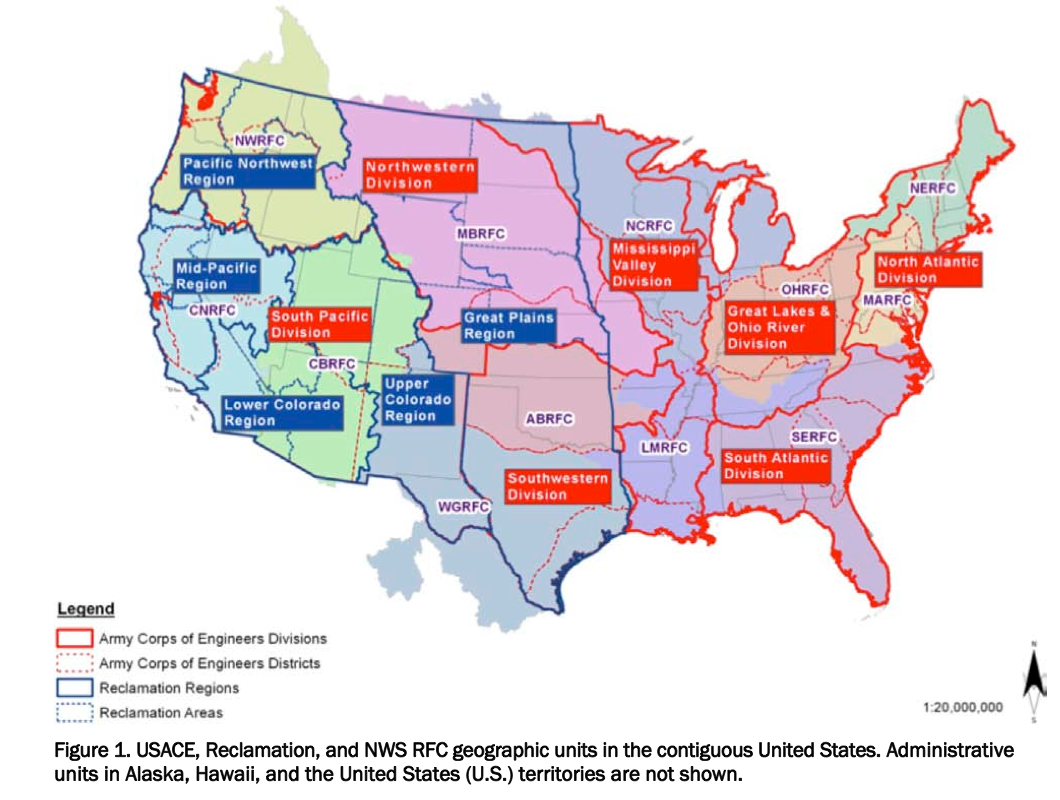U.S. ARMY CORPS OF ENGINEERS
Introduction
The U.S. Army Corps of Engineers (USACE) is the largest water resources operating agency in the United States. For more than 230 years, USACE has supplied engineering solutions for water resources needs, including navigation, flood and coastal storm damage reduction, protection and restoration of aquatic ecosystems, hydropower, water supply, recreation, regulatory, and disaster preparedness and response. The Bureau of Reclamation (Reclamation) was established 107 years ago with a mission centered on constructing irrigation projects in the Western United States, many of which are still functioning today. Since its creation, Reclamation’s mission has evolved to include hydroelectric generation, municipal and industrial water supply projects, water reuse, ecosystem restoration, dam safety, and the protection and management of water supplies. The National Weather Service (NWS) and its parent agency, the National Oceanic and Atmospheric Administration (NOAA), are the primary Federal weather, water, and climate forecast agencies. NWS’s functions related to hydrologic monitoring and forecasting are carried out through a national network of River Forecast Centers (RFCs) .
USACE and Reclamation offer separate and complementary water management missions. While the purposes and objectives may vary by system, a common feature of each system is that it was designed to operate within an envelope of climate, weather, and hydrologic variability—also known as hydroclimate variability. Monitoring hydroclimate conditions and anticipating short-term variations in these conditions are a central part of USACE and Reclamation water management. Indeed, it is for this short-term time scale—from subdaily to interannual—where USACE and Reclamation make the most decisions. The processes leading up to these decisions often involve preparing short-term management outlooks that are constrained by authorized purposes and informed by a mix of considerations, including current system conditions, regulatory and institutional constraints, anticipated customer expectations, and consideration of current and forecast hydroclimate conditions. As for the latter, consideration of forecast information varies by agency and system in helping to influence short-term decisions, ranging from explicit, to subjective use, and sometimes to no reliance at all.
The practices used by USACE and Reclamation to develop short-term water management outlooks and associated decisions have been well established over the decades. Complementing these processes is a network of Federal hydroclimate monitoring and forecasting services, led by NOAA’s NWS, the U.S. Geological Survey (USGS), and U.S. Department of Agriculture’s Natural Resources Conservation Service (NRCS). These forecasting agencies share a long history with management agencies, providing them with a variety of services and products that are meant to be flexible in serving a multitude of management needs.
Both management and forecasting agencies recognize that management agencies currently utilize only a share of the hydroclimate monitoring and forecasting products currently being created by forecasting agencies. The reasons for this are many, including perceptions about product skill and reliability, lack of understanding about the potential decision-support value of the available information products, and limitations in the management agencies’ capacity to consume and utilize such products during development. Additionally, decision making processes within Federal and non-Federal agencies are established and evolve in conjunction with management needs and new technologies. Adoption rates and incorporation the development of new information exist in conjunction with these decision making processes.
This document explores these situations and limitations, with the goal of ultimately describing the needs of water managers and operational hydroclimate service providers as they collectively work toward improving short-term water management decisions. It is envisioned that the needs discussed in this document may lead to research, development, and demonstration activities focused on both the improved use of existing hydroclimate monitoring and forecast products by management agencies and the development of superior quality products that might be made available through the forecasting agencies. To that end, this document provides an overview of management agencies’ short-term decision making processes as they vary from fine to coarse resolution in the short term, a summary of how hydroclimate information influences these processes, and a description of how current practices in both management and forecasting agencies present challenges and opportunities toward improvement.
Read full report (PDF) here: Short-Term Water Management Decisions
About the The U.S. Army Corps of Engineers
www.usace.army.mil
“The U.S. Army Corps of Engineers has approximately 37,000 dedicated Civilians and Soldiers delivering engineering services to customers in more than 90 countries worldwide. With environmental sustainability as a guiding principle, our disciplined Corps team is working diligently to strengthen our Nation’s security by building and maintaining America’s infrastructure and providing military facilities where our servicemembers train, work and live. We are also researching and developing technology for our war fighters while protecting America’s interests abroad by using our engineering expertise to promote stability and improve quality of life.”
Tags: Natural Resources Conservation Service, NRCS, U.S. Geological Surey, US Army Corps of Engineers, US Department of Agriculture, USACE, USGS







 RSS Feed
RSS Feed